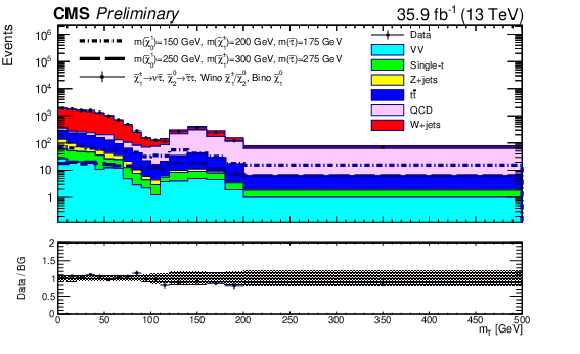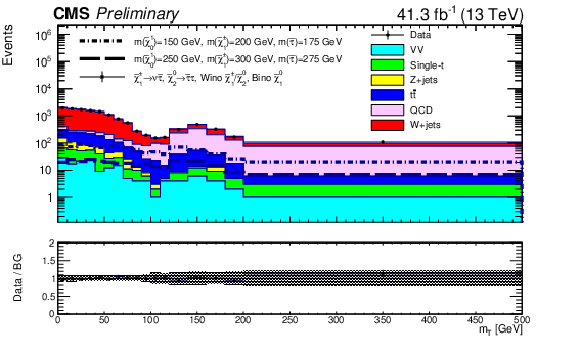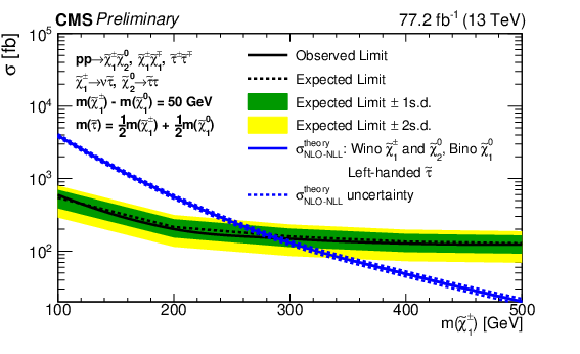

Compact Muon Solenoid
LHC, CERN
| CMS-PAS-SUS-19-002 | ||
| Search for supersymmetry with a compressed mass spectrum in events with a soft τ lepton, a highly energetic jet, and large missing transverse momentum in proton-proton collisions at √s= 13 TeV | ||
| CMS Collaboration | ||
| August 2019 | ||
| Abstract: The first search for supersymmetry in events with one soft tau lepton, one energetic jet from initial state radiation, and transverse momentum imbalance is presented. These event signatures are consistent with those from supersymmetric models exhibiting co-annihilation between the scalar tau lepton (˜τ) and the lightest neutralino (˜χ01) that could generate the observed relic density of dark matter. The data correspond to an integrated luminosity of 77.2 fb−1 of proton-proton collisions at √s= 13 TeV collected with the CMS detector at the CERN LHC in 2016 and 2017. The results are interpreted considering a supersymmetric scenario with a small mass difference (Δm) between the chargino (˜χ±1) or the next-to-lightest neutralino (˜χ02), and the lightest neutralino. The mass of the ˜τ is defined as the average of the ˜χ±1/˜χ02 and ˜χ01 masses. The data are found to be consistent with the standard model background predictions. Upper limits at 95% confidence level are set on the ˜χ±1, ˜χ02, and ˜τ production cross sections for Δm(˜χ±1,˜χ01)= 50 GeV, resulting in a lower mass limit of 290 GeV on the mass of the ˜χ±1/˜χ02, which is the most stringent to date. | ||
|
Links:
CDS record (PDF) ;
CADI line (restricted) ;
These preliminary results are superseded in this paper, PRL 124 (2020) 041803. The superseded preliminary plots can be found here. |
||
| Figures | |

png pdf |
Figure 1:
The mT(pTmiss,τh) distribution for SR events with 2016 data (left) and 2017 data (right). On the top canvas of the figures, the solid colors correspond to the expected background processes, the black dots to the observed data, and the dashed lines to the expected signal from simulation. The bottom canvas of the figures show the ratio between the observed data and the total expected background. The shaded band correspond to the total statistical uncertainty. |

png pdf |
Figure 1-a:
The mT(pTmiss,τh) distribution for SR events with 2016 data (left) and 2017 data (right). On the top canvas of the figures, the solid colors correspond to the expected background processes, the black dots to the observed data, and the dashed lines to the expected signal from simulation. The bottom canvas of the figures show the ratio between the observed data and the total expected background. The shaded band correspond to the total statistical uncertainty. |

png pdf |
Figure 1-b:
The mT(pTmiss,τh) distribution for SR events with 2016 data (left) and 2017 data (right). On the top canvas of the figures, the solid colors correspond to the expected background processes, the black dots to the observed data, and the dashed lines to the expected signal from simulation. The bottom canvas of the figures show the ratio between the observed data and the total expected background. The shaded band correspond to the total statistical uncertainty. |

png pdf |
Figure 2:
The plot on the left shows the 95% confidence level (CL) upper limits on the ˜χ±1 and ˜χ02 pair production cross sections in SSM1, as function of m(˜χ±1). The solid blue line corresponds to the theoretical cross section. The observed limit is shown with the solid black line, while the expected limit is represented with the dashed black line. The yellow (green) band corresponds to the one (two) standard deviation from the central value of the expected limit. The plot on the right, top canvas, presents the ratio of the 95% CL upper limit on the direct ˜τ pair production signal cross section in SSM2 to the theoretical cross section, as function of m(˜τ) and Δm(˜τ,˜χ01). The bottom canvas presents the 95% CL upper limits on the direct ˜τ pair production signal cross sections in SSM2, as function of m(˜τ) for m(˜τ)−m(˜χ01)= 50 GeV. The extremely small ˜τ˜τ production cross sections make these SSM2 scenarios very challenging, especially when Δm(˜τ,˜χ01)< 50 GeV. For a ˜τ mass of 100 GeV, the observed limit is about 10 times the theoretical cross section. |

png pdf |
Figure 2-a:
The plot on the left shows the 95% confidence level (CL) upper limits on the ˜χ±1 and ˜χ02 pair production cross sections in SSM1, as function of m(˜χ±1). The solid blue line corresponds to the theoretical cross section. The observed limit is shown with the solid black line, while the expected limit is represented with the dashed black line. The yellow (green) band corresponds to the one (two) standard deviation from the central value of the expected limit. The plot on the right, top canvas, presents the ratio of the 95% CL upper limit on the direct ˜τ pair production signal cross section in SSM2 to the theoretical cross section, as function of m(˜τ) and Δm(˜τ,˜χ01). The bottom canvas presents the 95% CL upper limits on the direct ˜τ pair production signal cross sections in SSM2, as function of m(˜τ) for m(˜τ)−m(˜χ01)= 50 GeV. The extremely small ˜τ˜τ production cross sections make these SSM2 scenarios very challenging, especially when Δm(˜τ,˜χ01)< 50 GeV. For a ˜τ mass of 100 GeV, the observed limit is about 10 times the theoretical cross section. |

png pdf |
Figure 2-b:
The plot on the left shows the 95% confidence level (CL) upper limits on the ˜χ±1 and ˜χ02 pair production cross sections in SSM1, as function of m(˜χ±1). The solid blue line corresponds to the theoretical cross section. The observed limit is shown with the solid black line, while the expected limit is represented with the dashed black line. The yellow (green) band corresponds to the one (two) standard deviation from the central value of the expected limit. The plot on the right, top canvas, presents the ratio of the 95% CL upper limit on the direct ˜τ pair production signal cross section in SSM2 to the theoretical cross section, as function of m(˜τ) and Δm(˜τ,˜χ01). The bottom canvas presents the 95% CL upper limits on the direct ˜τ pair production signal cross sections in SSM2, as function of m(˜τ) for m(˜τ)−m(˜χ01)= 50 GeV. The extremely small ˜τ˜τ production cross sections make these SSM2 scenarios very challenging, especially when Δm(˜τ,˜χ01)< 50 GeV. For a ˜τ mass of 100 GeV, the observed limit is about 10 times the theoretical cross section. |
| Summary |
| In summary, we have presented a search for compressed supersymmetry in the stau-neutralino (˜τ−˜χ01) coannihilation region. It is the first collider search with exactly one soft, hadronically-decaying tau (τ) lepton and a large transverse momentum imbalance (pmissT) resulting from the recoil effect of high transverse momentum jet from initial state radiation (ISR). The search utilizes data corresponding to an integrated luminosity of 77.2 fb−1 collected in 2016 and 2017 with the CMS detector in proton-proton collisions at √s= 13 TeV. This particular search targets compressed mass spectra where the mass difference between the chargino (˜χ±1), or the next-to-lightest neutralino (˜χ02), and the neutralino (˜χ01), denoted by (Δm), is 50 GeV. This is motivated by models considering ˜τ−˜χ01 co-annihilation aiming to maintain consistency in the estimation of the relic dark matter density between particle physics and cosmology. In the context of the minimal supersymmetric standard model (MSSM), the search considers purely electroweak production of ˜τs via cascading decays of ˜χ±1s and ˜χ02s as well as direct production of ˜τs. The data do not reveal any evidence for new physics. The results are used to exclude a range of ˜χ±1 masses for a mass splitting Δm(˜χ±1,˜χ01) of 50 GeV. For Δm(˜χ±1,˜χ01)= 50 GeV and Br(˜χ±1→˜τν→τ˜χ01ν)=100, ˜χ±1 masses up to 290 GeV are excluded at 95% CL. This sensitivity exceeds that of other ˜τ searches to date. |
| References | ||||
| 1 | P. Ramond | Dual theory for free fermions | PRD 3 (1971) 2415 | |
| 2 | Y. A. Gol'fand and E. P. Likhtman | Extension of the algebra of Poincare group generators and violation of P invariance | JEPTL 13 (1971) 323 | |
| 3 | S. Ferrara and B. Zumino | Supergauge invariant Yang-Mills theories | NPB 79 (1974) 413 | |
| 4 | J. Wess and B. Zumino | Supergauge transformations in four dimensions | NPB 70 (1974) 39 | |
| 5 | A. H. Chamseddine, R. Arnowitt, and P. Nath | Locally Supersymmetric Grand Unification | PRL 49 (1982) 970 | |
| 6 | R. Barbieri, S. Ferrara, and C. A. Savoy | Gauge models with spontaneously broken local supersymmetry | PLB 119 (1982) 343 | |
| 7 | L. Hall, J. Lykken, and S. Weinberg | Supergravity as the messenger of supersymmetry breaking | PRD 27 (1983) 2359 | |
| 8 | S. Dimopoulos and G. F. Giudice | Naturalness constraints in supersymmetric theories with nonuniversal soft terms | PLB 357 (1995) 573 | hep-ph/9507282 |
| 9 | WMAP Collaboration | First year Wilkinson Microwave Anisotropy Probe (WMAP) observations: Determination of cosmological parameters | Astrophys. J. Suppl. 148 (2003) 175--194 | astro-ph/0302209 |
| 10 | Planck Collaboration | Planck 2015 results. XIII. Cosmological parameters | Astron. Astrophys. 594 (2016) A13 | 1502.01589 |
| 11 | R. L. Arnowitt et al. | Detection of SUSY signals in stau neutralino co-annihilation region at the LHC | AIP Conf. Proc. 903 (2007) 229 | hep-ph/0611089 |
| 12 | V. Khotilovich, R. L. Arnowitt, B. Dutta, and T. Kamon | The Stau neutralino co-annihilation region at an international linear collider | PLB 618 (2005) 182 | hep-ph/0503165 |
| 13 | M. Carena et al. | Light Stau Phenomenology and the Higgs γγ Rate | JHEP 07 (2012) 175 | 1205.5842 |
| 14 | A. Aboubrahim, P. Nath, and A. B. Spisak | Stau coannihilation, compressed spectrum, and SUSY discovery potential at the LHC | PRD 95 (2017) 115030 | 1704.04669 |
| 15 | G. H. Duan et al. | Vacuum stability in stau-neutralino coannihilation in MSSM | PLB 788 (2019) 475 | 1809.10061 |
| 16 | R. Arnowitt et al. | Determining the dark matter relic density in the minimal supergravity stau-neutralino coannihilation region at the large hadron collider | PRL 100 (2008) 231802 | hep-ph/08022968 |
| 17 | B. Dutta et al. | Vector boson fusion processes as a probe of supersymmetric electroweak sectors at the LHC | PRD 87 (2013) 035029 | 1210.0964 |
| 18 | A. G. Delannoy et al. | Probing Dark Matter at the LHC Using Vector Boson Fusion Processes | PRL 111 (2013) 061801 | 1304.7779 |
| 19 | A. Florez et al. | Probing the Stau-Neutralino Coannihilation Region at the LHC with a soft tau lepton and an ISR jet | PRD 94 (2016) 073007 | hep-ph/160608878 |
| 20 | CMS Collaboration | Combined search for electroweak production of charginos and neutralinos in proton-proton collisions at √s= 13 TeV | JHEP 03 (2018) 160 | CMS-SUS-17-004 1801.03957 |
| 21 | CMS Collaboration | Search for new physics in events with two soft oppositely charged leptons and missing transverse momentum in proton-proton collisions at √s= 13 TeV | PLB 782 (2018) 440 | CMS-SUS-16-048 1801.01846 |
| 22 | ATLAS Collaboration | Search for the direct production of charginos and neutralinos in final states with tau leptons in √s=13TeVpp collisions with the ATLAS detector | EPJC 78 (2018) 154 | 1708.07875 |
| 23 | ATLAS Collaboration | Search for electroweak production of supersymmetric states in scenarios with compressed mass spectra at √s= 13 TeV with the ATLAS detector | PRD 97 (2017) 052010 | 1712.08119 |
| 24 | ALEPH Collaboration | Search for scalar leptons in e+ e- collisions at center-of-mass energies up to 209-GeV | PLB 526 (2002) 206 | hep-ex/0112011 |
| 25 | DELPHI Collaboration | Searches for supersymmetric particles in e+ e- collisions up to 208-GeV and interpretation of the results within the MSSM | EPJC 31 (2003) 421 | hep-ex/0311019 |
| 26 | L3 Collaboration | Search for scalar leptons and scalar quarks at LEP | PLB 580 (2004) 37 | hep-ex/0310007 |
| 27 | OPAL Collaboration | Search for anomalous production of dilepton events with missing transverse momentum in e+ e- collisions at √s= 183-Gev to 209-GeV | EPJC 32 (2004) 453 | hep-ex/0309014 |
| 28 | CMS Collaboration | The CMS experiment at the CERN LHC | JINST 3 (2008) S08004 | CMS-00-001 |
| 29 | CMS Collaboration | Particle-flow reconstruction and global event description with the cms detector | JINST 12 (2017) P10003 | CMS-PRF-14-001 1706.04965 |
| 30 | M. Cacciari, G. P. Salam, and G. Soyez | The anti-kT jet clustering algorithm | JHEP 04 (2008) 063 | 0802.1189 |
| 31 | CMS Collaboration | Jet algorithms performance in 13 TeV data | CMS-PAS-JME-16-003 | CMS-PAS-JME-16-003 |
| 32 | CMS Collaboration | Jet energy scale and resolution in the CMS experiment in pp collisions at 8 TeV | JINST 12 (2017) P02014 | CMS-JME-13-004 1607.03663 |
| 33 | CMS Collaboration | Identification of heavy-flavour jets with the CMS detector in pp collisions at 13 TeV | JINST 13 (2018) P05011 | CMS-BTV-16-002 1712.07158 |
| 34 | CMS Collaboration | Performance of electron reconstruction and selection with the CMS detector in proton-proton collisions at √s= 8 TeV | JINST 10 (2015) P06005 | CMS-EGM-13-001 1502.02701 |
| 35 | CMS Collaboration | Performance of the CMS muon detector and muon reconstruction with proton-proton collisions at √s= 13 TeV | JINST 13 (2018) P06015 | CMS-MUO-16-001 1804.04528 |
| 36 | CMS Collaboration | Performance of reconstruction and identification of τ leptons decaying to hadrons and ντ in pp collisions at √s= 13 TeV | JINST 13 (2018) P10005 | CMS-TAU-16-003 1809.02816 |
| 37 | J. Alwall et al. | The automated computation of tree-level and next-to-leading order differential cross sections, and their matching to parton shower simulations | JHEP 07 (2014) 079 | 1405.0301 |
| 38 | T. Sjostrand et al. | An introduction to PYTHIA 8.2 | CPC 191 (2015) 159 | 1410.3012 |
| 39 | CMS Collaboration | Event generator tunes obtained from underlying event and multiparton scattering measurements | EPJC 76 (2016) 155 | CMS-GEN-14-001 1512.00815 |
| 40 | GEANT4 Collaboration | GEANT4: A Simulation toolkit | NIMA506 (2003) 250--303 | |
| 41 | CMS Collaboration | The fast simulation of the CMS detector at LHC | J. Phys. Conf. Ser. 331 (2011) 032049 | |
| 42 | J. Debove, B. Fuks, and M. Klasen | Threshold resummation for gaugino pair production at hadron colliders | NPB 842 (2011) 51--85 | 1005.2909 |
| 43 | B. Fuks, M. Klasen, D. R. Lamprea, and M. Rothering | Gaugino production in proton-proton collisions at a center-of-mass energy of 8 TeV | JHEP 10 (2012) 081 | 1207.2159 |
| 44 | B. Fuks, M. Klasen, D. R. Lamprea, and M. Rothering | Precision predictions for electroweak superpartner production at hadron colliders with \sc Resummino | EPJC 73 (2013) 2480 | 1304.0790 |
| 45 | J. Fiaschi and M. Klasen | Neutralino-chargino pair production at NLO+NLL with resummation-improved parton density functions for LHC Run II | PRD 98 (2018), no. 5, 055014 | 1805.11322 |
| 46 | J. Butterworth et al. | PDF4LHC recommendations for LHC run II | JPG 43 (2016) 023001 | 1510.03865 |
| 47 | P. M. Nadolsky et al. | Implications of CTEQ global analysis for collider observables | PRD 78 (2008) 013004 | 0802.0007 |
| 48 | A. D. Martin, W. J. Stirling, R. S. Thorne, and G. Watt | Update of parton distributions at NNLO | PLB 652 (2007) 292 | 0706.0459 |
| 49 | M. Ubiali | NNPDF1.0 parton set for the LHC | NPPS 186 (2009) 62 | 0809.3716 |
| 50 | T. Junk | Confidence level computation for combining searches with small statistics | NIMA 434 (1999) 435 | hep-ex/9902006 |
| 51 | A. L. Read | Presentation of search results: the CLs technique | JPG 28 (2002) 2693 | |
| 52 | ATLAS and CMS Collaborations | Procedure for the LHC Higgs boson search combination in Summer 2011 | CMS-NOTE-2011-005 | |
| 53 | R. J. Barlow and C. Beeston | Fitting using finite Monte Carlo samples | CPC 77 (1993) 219 | |

|
Compact Muon Solenoid LHC, CERN |

|

|

|

|

|

|